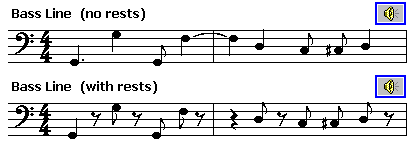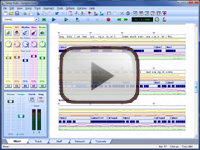(5.5) Rest Symbols
In music, the spaces between notes are often as important as the notes themselves.
If this sounds strange to you, imagine listening to someone giving a speech who never paused for a breath! It would soon sound painfully monotonous, and your ear would crave for a break to give relief to the unending stream of words.
Likewise with music it is important to provide spaces, allowing the listener to absorb each musical phrase before the next one starts. This goes a long way towards creating satisfying music, with good dynamic balance between musical activity and rest.
Even within a phrase, rests can be used with great effect to add strength to the rhythm of the melody.
Compare the two bass lines below. One uses full length notes, while the other uses shorter notes with rests in between. You can hear that the second version sounds much more punchy, because the discontinuities at the end of each note also contribute to the rhythm, making it richer and tighter.

As with note symbols, there is a series of symbols used for rests, each one half the length of its neighbour. In fact, there is an equivalent length rest for every note symbol that we covered earlier.

Normally rest symbols are placed in the same way as note symbols, evenly spaced across the bar from left to right. The whole-rest is something of an exception, because it generally occupies the whole bar, and so it is placed in the centre.
The whole-rest also has the special feature of some flexibility in its length. While it has a theoretical length of four quarter-notes, it is common to use it for a full bar of rest in any meter. So for music in 3/4 time (such as the Skater's Waltz earlier) the whole-rest would have a length of only three quarter-notes.

The half-rest looks similar to the whole-rest, but you will see that it sits above the third staff line, rather than hanging from the fourth line (staff lines are numbered starting from the bottom).
Both it and the quarter-rest can be mixed in with note or other rest symbols wherever they are needed. Two or more rest symbols together simply extends the size of the rest to their total length.


The eighth-rest, sixteenth-rest, thirty-second-rest and sixty-fourth-rest use the same basic figure, but each has an extra hook. Notice how this closely parallels the way their equivalent note symbols are constructed, with each having an extra flag.
Now let's see how the two versions of our bass line would look when written in staff notation both with and without rests.

ChordWizard products such as Songtrix include rests automatically when they prepare the staff notation of a piece of music for you.
As you edit or record the musical events that make up your song, Songtrix updates the layout of Staff View to include rest symbols wherever there are gaps between your events.















